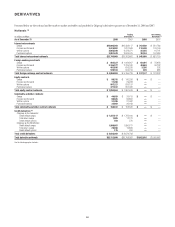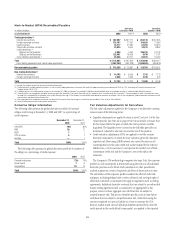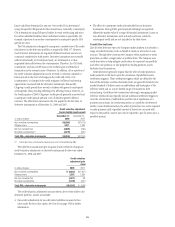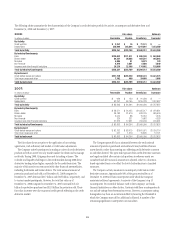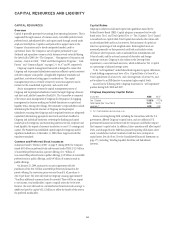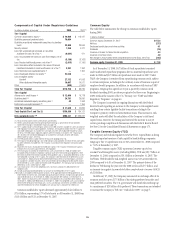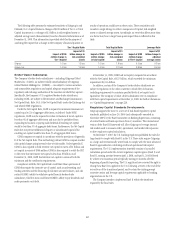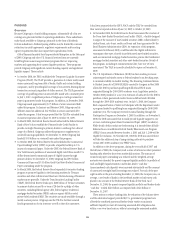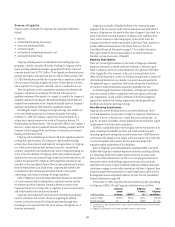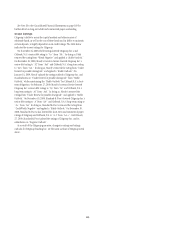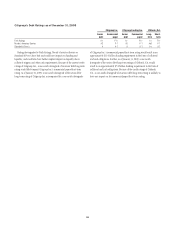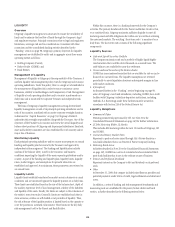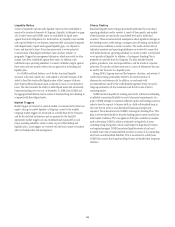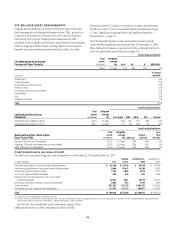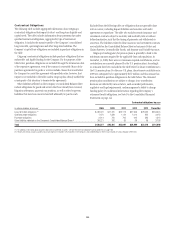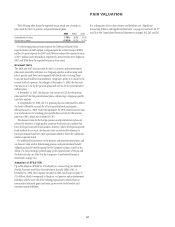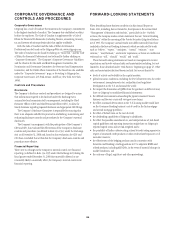Citibank 2008 Annual Report Download - page 105
Download and view the complete annual report
Please find page 105 of the 2008 Citibank annual report below. You can navigate through the pages in the report by either clicking on the pages listed below, or by using the keyword search tool below to find specific information within the annual report.
Sources of Liquidity
Primary sources of liquidity for Citigroup and its principal subsidiaries
include:
• deposits;
• collateralized financing transactions;
• senior and subordinated debt;
• commercial paper;
• trust preferred and preferred securities; and
• purchased/wholesale funds.
Citigroup’s funding sources are diversified across funding types and
geography, a benefit of its global franchise. Funding for Citigroup and its
major operating subsidiaries includes a geographically diverse retail and
corporate deposit base of $774.2 billion. These deposits are diversified across
products and regions, with approximately two-thirds of them outside of the
U.S. This diversification provides the Company with an important, stable and
low-cost source of funding. A significant portion of these deposits has been,
and is expected to be, long-term and stable, and are considered to be core.
There are qualitative as well as quantitative assessments that determine the
Company’s calculation of core deposits. The first step in this process is a
qualitative assessment of the deposits. For example, as a result of the Company’s
qualitative analysis certain deposits with wholesale funding characteristics are
excluded from consideration as core. Deposits that qualify under the Company’s
qualitative assessments are then subjected to quantitative analysis.
Excluding the impact of changes in foreign exchange rates and the sale
of our retail banking operations in Germany during the year ending
December 31, 2008, the Company’s deposit base remained stable. On a
volume basis, deposit increases were noted in Transaction Services, U.S.
Retail Banking and Smith Barney. This was partially offset by the Company’s
decision to reduce deposits considered wholesale funding, consistent with the
Company’s de-leveraging efforts, and declines in International Consumer
Banking and the Private Bank.
Citigroup and its subsidiaries have historically had a significant presence
in the global capital markets. The Company’s capital markets funding
activities have been primarily undertaken by two legal entities: (i) Citigroup
Inc., which issues long-term debt, medium-term notes, trust preferred
securities, and preferred and common stock; and (ii) Citigroup Funding Inc.
(CFI), a first-tier subsidiary of Citigroup, which issues commercial paper,
medium-term notes and structured equity-linked and credit-linked notes, all
of which are guaranteed by Citigroup. Other significant elements of long-
term debt on the Consolidated Balance Sheet include collateralized advances
from the Federal Home Loan Bank system, long-term debt related to the
consolidation of ICG’s Structured Investment Vehicles, asset-backed
outstandings, and certain borrowings of foreign subsidiaries.
Each of Citigroup’s major operating subsidiaries finances its operations
on a basis consistent with its capitalization, regulatory structure and the
environment in which it operates. Particular attention is paid to those
businesses that for tax, sovereign risk, or regulatory reasons cannot be freely
and readily funded in the international markets.
Citigroup’s borrowings have historically been diversified by geography,
investor, instrument and currency. Decisions regarding the ultimate
currency and interest rate profile of liquidity generated through these
borrowings can be separated from the actual issuance through the use of
derivative instruments.
Citigroup is a provider of liquidity facilities to the commercial paper
programs of the two primary Credit Card securitization trusts with which it
transacts. Citigroup may also provide other types of support to the trusts. As a
result of the recent economic downturn, its impact on the cashflows of the
trusts, and in response to credit rating agency reviews of the trusts, the
Company increased the credit enhancement in the Omni Trust, and plans to
provide additional enhancement to the Master Trust (see Note 23 to
Consolidated Financial Statements on page 175 for a further discussion).
This support preserves investor sponsorship of our card securitization
franchise, an important source of liquidity.
Banking Subsidiaries
There are various legal limitations on the ability of Citigroup’s subsidiary
depository institutions to extend credit, pay dividends or otherwise supply
funds to Citigroup and its non-bank subsidiaries. The approval of the Office
of the Comptroller of the Currency, in the case of national banks, or the
Office of Thrift Supervision, in the case of federal savings banks, is required if
total dividends declared in any calendar year exceed amounts specified by
the applicable agency’s regulations. State-chartered depository institutions
are subject to dividend limitations imposed by applicable state law.
In determining the declaration of dividends, each depository institution
must also consider its effect on applicable risk-based capital and leverage
ratio requirements, as well as policy statements of the federal regulatory
agencies that indicate that banking organizations should generally pay
dividends out of current operating earnings.
Non-Banking Subsidiaries
Citigroup also receives dividends from its non-bank subsidiaries. These
non-bank subsidiaries are generally not subject to regulatory restrictions on
dividends. However, as discussed in “Capital Resources and Liquidity” on
page 94, the ability of CGMHI to declare dividends can be restricted by capital
considerations of its broker-dealer subsidiaries.
CGMHI’s consolidated balance sheet is liquid, with the vast majority of its
assets consisting of marketable securities and collateralized short-term
financing agreements arising from securities transactions. CGMHI monitors
and evaluates the adequacy of its capital and borrowing base on a daily basis
to maintain liquidity and to ensure that its capital base supports the
regulatory capital requirements of its subsidiaries.
Some of Citigroup’s non-bank subsidiaries, including CGMHI, have credit
facilities with Citigroup’s subsidiary depository institutions, including Citibank,
N.A. Borrowings under these facilities must be secured in accordance with
Section 23A of the Federal Reserve Act. There are various legal restrictions on
the extent to which a bank holding company and certain of its non-bank
subsidiaries can borrow or obtain credit from Citigroup’s subsidiary depository
institutions or engage in certain other transactions with them. In general, these
restrictions require that transactions be on arm’s length terms and be secured
by designated amounts of specified collateral. See Note 20 to the Consolidated
Financial Statements on page 169.
At December 31, 2008, long-term debt and commercial paper outstanding
for Citigroup, CGMHI, CFI and Citigroup’s subsidiaries were as follows:
In billions of dollars
Citigroup
parent
company CGMHI (2)
Citigroup
Funding
Inc. (2)
Other
Citigroup
subsidiaries
Long-term debt $192.3 $20.6 $37.4 $109.3 (1)
Commercial paper $ — $ — $28.6 $ 0.5
(1) At December 31, 2008, approximately $67.4 billion relates to collateralized advances from the Federal
Home Loan Bank.
(2) Citigroup Inc. guarantees all of CFI’s debt and CGMHI’s publicly issued securities.
99



